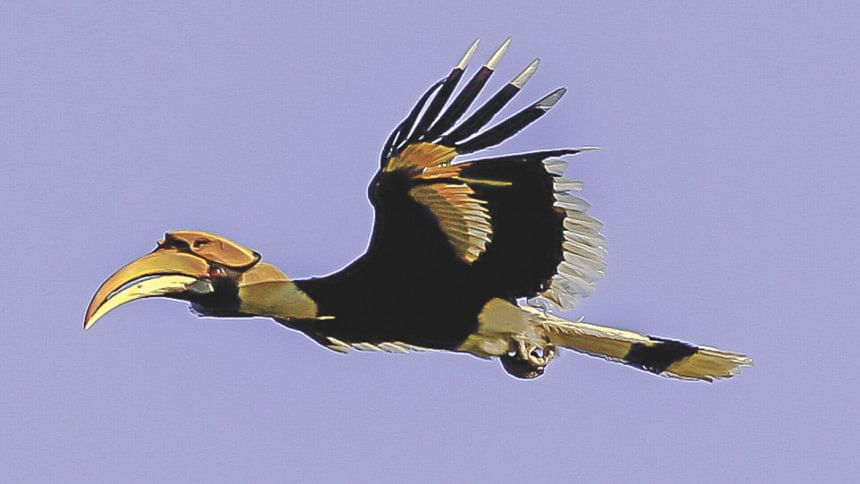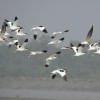Nature Quest: Our last Great Hornbills

If you have been to Bandarban town, you have probably seen a sculpture of a massive bird with a large bill sitting proudly in the heart of the city and probably wondered if this bird belongs to our land. During my travels to the remote parts of the Chittagong Hill Tracts, I witnessed numerous skulls of the Great Hornbills in almost every indigenous village I visited. I waited for hours and sometimes days underneath fig trees to watch the Great Hornbill landing on the tree canopy, hopping from one branch to another, plucking fruit, tossing it up in the air, swallowing it and then soaring into the sky to find another feast, spreading the enormous wings and emitting huffing sounds that echo through the land.
There were days when we covered great distances in the secluded Bandarban to find our last hornbills, to understand its population status, to capture their behaviour in frames and to share with others who have not visited the vast valleys and high hills of Bangladesh. There is a profound pleasure in finally having seen a sight or reached a destination that has occupied the heart and mind for months, a view or encounter that is comprehendible yet mysterious to one's experience. This happened to me in June 2014 when my travel mate Prince and I travelled towards the source of Matamuhuri river in search of the Great Hornbill.
Monsoon is not an ideal season for expeditions to hilly terrains but this was our only feasible option to invest our time in finding hornbills, as they are less mobile during the nesting season. Our spirit was soaring high even after several failed attempts to have a glimpse of the hornbills in the past few winters. The rain was a constant company as we travelled through the Matamuhuri river on a small wooden motorboat packed with locals. It was a happy crowd, as the jovial spirit of hill men revived with frequent giggles.
Every Mro carried a black umbrella and kept the canopy unfolded, firmly holding the wooden rib even when it did not rain. When it rained, the sound of sharp drops on the umbrellas, on moving water and on riverside vegetation conveyed a sense of harmony, even the noise of engine did not intrude. I peered out from the cluster of umbrellas, looked at the blurred hills where trees had gone wild to fight the mighty wind by gripping the russet soil with great strength of their roots.
The boat dropped us off at our destination just before dusk. From there, we had to climb a few hundred feet to a Mro village. The hike was tiring, yet pleasant with tree ferns and dense undergrowth embellishing both sides of the narrow trail, the high-pitched calls of Hooded Pitta, sporadic shrills of Bay Woodpecker and the outline of the waning sun's golden-brown hue behind the fence of thick foliage. Sliding and slipping in the rain, we reached a ridge where the village stood with only a few bamboo huts. I dropped my rucksack at the village headman's hut and looked out over the dark and motionless hill in the distance where the Great Hornbills roam.
It rained all night and then there was silence, the rustling of leaves stopped, the wall of vegetation stood around the village like a piece of heavy cloud. No bird flew or sang, even the cicadas were quiet and the army of ants vanished underneath the ground. I felt the humidity on my face and the intense light momentarily blinded me as I looked up to the morning sun.
After a heavy meal we set off through the Jhum land to find our birds. The Great Hornbill has disappeared from much of its range but still occurs in good numbers in and around Sangu-Matamuhuri and Kassalong Reserve Forests of Chittagong Hill Tracts. Habitat loss, hunting and poaching of chicks are the main threats to these magnificent creatures.
The barren hill was still wet and when the sun shone on the soil, layers of scorching air rolled over the land. We descended and ascended for five hours to get to the next green spot, where my Mro friend saw a hornbill's nest exactly 11 months ago. At 1,800ft, we stopped at a Jhum hut to catch our breath where a lone Rufous-bellied Eagle circled overhead. While the elation of finding this rare eagle was still fresh, my Mro friend whispered to listen to the wind cautiously. I held my breath and immediately heard whooshing sounds, followed by raucous calls. We jumped out of the hut and witnessed two Great Hornbills flying above us. They roared as though they are the tigers of the sky and ruled the air with wings spanning five feet.
The excitement grew as we approached towards the nesting site and when the carpet of wet leaves underfoot felt thicker, an unfathomable forest loomed ahead of us. The pebbly streams were murky. The sunlight reached the ground across the stream where vegetation lacked and reflected a subdued tone below the canopy with its very glittering nature.
All went well until we found the empty nest and later thought that poachers took the chicks and sold them at a local market for a meagre amount. We saw the parent hornbills screaming around the bare nest. Would people, I wondered, still buy these wild birds from poachers if they hear the cry of hornbill parents or see the freedom in their fights?
The writer is a Conservation Biologist, currently working on threatened species conservation and research in Bangladesh and abroad.

 For all latest news, follow The Daily Star's Google News channel.
For all latest news, follow The Daily Star's Google News channel. 








Comments